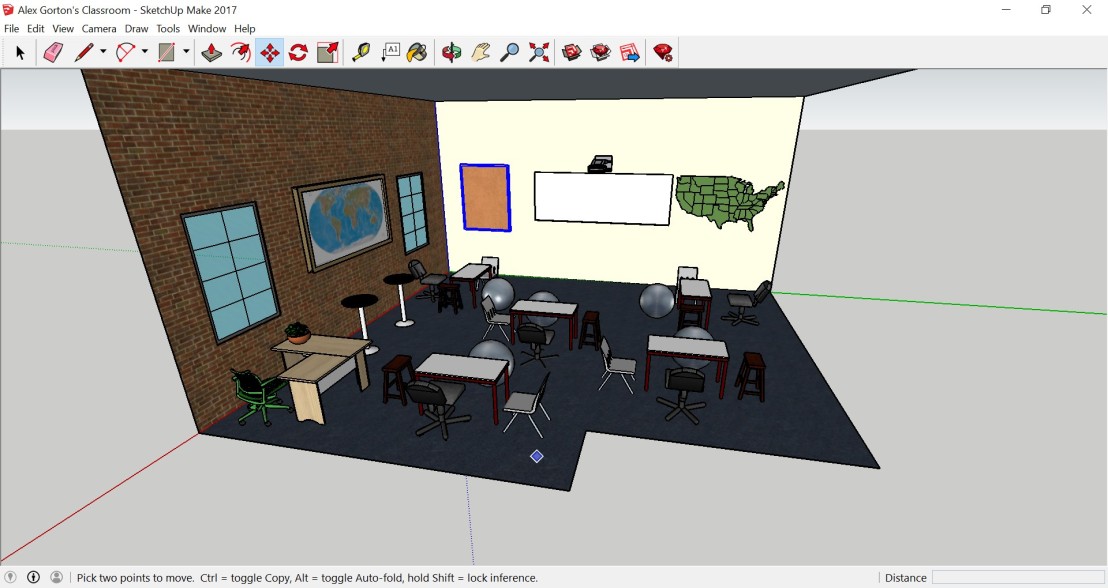As the school year approaches, I need to set up my classroom. This is always an exciting and difficult time for me. From my undergraduate studies and now into my graduate studies there has been a lot of emphasis placed on classroom design and creating a welcoming and productive environment. I’ve tried two different groupings of desks in the last two years and I would like to try something new this year. Having moved rooms, I am excited to work on redesigning my classroom.
The space I will be redesigning is my eighth and ninth grade classroom. The space I have now is open, contains a lot of storage, and has great windows with a lot of light. Our school, being an old canning building, has a very industrial feel and so does my room. The ceiling has exposed beams and vents. Before any type of redesign, this space is already very modern looking. Obviously, this redesign will impact myself, but my main target audience is my students, administration, and any other colleagues.

Redesigning this space will create an environment which promotes student success and creates a comfortable environment. Having students placed in groups as opposed to rows, promotes student interaction. This new type of environment will also change the way I am able to move around the room and how I teach. In my first year, students were in rows and I found it very difficult to move up down the rows and place students into groups. In my second year, I had students already in groups and was able to conduct much more group work. With this redesign I hope to promote collaboration, communication, and a sense of community within my room.
In redesigning my classroom, I will focus on creating an environment in which students are able to tinker, experiment, and learn from multiple attempts. Kahl’s (2012) article argues classrooms need to create a culture of critical collaboration. This means everyone is able to learn from their peers and see their achievements and struggles. This type of environment is focused on the process instead of the end result. Public projects mean they are open for public criticism. Having a classroom with tables and groups where students work in front of each other makes a public learning space. Students are able to see other student’s working and ask why, what if, and how questions as they work (Berger 2014). Why did that student do the project a different way? What if I did my project that way? How can I make my project unique still?

I’ve decided to put my desk in the back of the room and somewhat corner myself off. This provides plenty of space for the students to work and be the center of the room. I like this idea because I am giving up some of my authority and spotlight and giving it more to the students. Now students are able to work together and learn from each other.
I’ve always been a poster person and I love hanging stuff up in my room. This year I want to find the correct balance of helpful and not distracting. Barret (2013) argues having a few complex visual creates stimulation. I would like to these types of visuals, but also have a small section dedicated to student work.

I’ve decided to use rectangular tables in my classroom because they can be moved around and create large groups or tables if needed. The tables I choose also have a whiteboard type surface allowing students to make their ideas public. Again this creates a collaborative environment for students to learn from each other. Around the tables, I provided flexible seating. Using the ideas from Mr. Riedl, I will allow students to choose their type seating at the beginning of each week. Students will be able to choose from regular chairs, swivel chairs, office chairs, yoga balls, or even standing.
To know if this space meets the needs of my stakeholders I will need to be observant. With collaboration, I will need to see if students are working together or if they are isolated. I will also need to create an environment where failure is acceptable. Students and I will need to celebrate failures and turn them into success.
Much like many things in education, there is never one solution to these types of problems. As I stated at the beginning of this blog post, I looked forward to redesigning my classroom every year. This year is no different and I hope my students will appreciate the effort I’ve put into this year’s design.
________________________________________________________________________________
References
Barrett, P., Zhang, Y., Moffat, J., & Kobbacy, K. (2013). A holistic, multi-level analysis identifying the impact of classroom design on on pupils’ learning. Building and Environment, 59, 678-689. doi: http://dx.doi.org/10.1016/j.buildenv.2012.09.016
Berger, Warren. (2014). A More Beautiful Question: The Power of Inquiry to Spark Breakthrough Ideas. New York: Bloomsbury.
Kahl, M. (2012, January 09). 4 Lessons the Classroom Can Learn from the Design Studio. Retrieved August 08, 2017, from http://www.creativitypost.com/education/4_lessons_the_classroom_can_learn_from_the_design_studio
R. (2017, May 17). Retrieved August 12, 2017, from https://www.youtube.com/watch?v=mUwtEpRB1XM
All pictures provided by Alex Gorton. Classroom replica created using SketchUp.